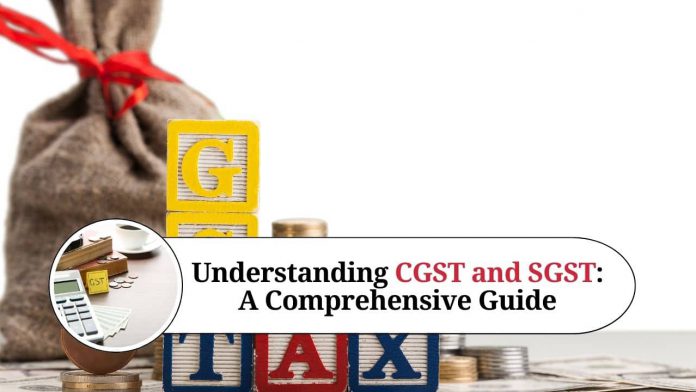In India, the Goods and Services Tax (GST) was introduced on July 1, 2017, to replace the multiple indirect taxes levied by the state and central governments. The GST is a single tax that is levied on the supply of goods and services throughout the country. The GST is composed of two components: the Central Goods and Services Tax (CGST) and the State Goods and Services Tax (SGST). In this article, we will explain what CGST and SGST are, how they work, and what their implications are.
What is CGST?
The CGST is a tax that is levied by the central government on the supply of goods and services within a state. The CGST is governed by the Central Goods and Services Tax Act, of 2017, and is levied on the value of the goods or services. The CGST is payable to the central government, and the revenue generated from the tax is shared with the state government where the goods or services are supplied.
How does CGST work?
When a supplier supplies goods or services within a state, they are required to charge CGST and SGST on the invoice. The supplier is required to deposit the CGST amount with the central government. The CGST amount is then shared with the state government where the goods or services were supplied. The CGST is calculated based on the value of the goods or services, including any taxes or duties paid on the goods or services.
What are the implications of CGST?
The CGST has several implications for businesses operating in India. Firstly, businesses need to ensure that they are registered under the GST regime and have obtained a GSTIN. Secondly, businesses need to ensure that they charge the correct amount of CGST on their invoices. Failure to do so can result in penalties and fines. Finally, businesses need to ensure that they deposit the CGST amount with the central government promptly.
What is SGST?
The SGST is a tax that is levied by the state government on the supply of goods and services within a state. The SGST is governed by the State Goods and Services Tax Act, of 2017, and is levied on the value of the goods or services. The SGST is payable to the state government, and the revenue generated from the tax is retained by the state government.
How does SGST work?
When a supplier supplies goods or services within a state, they are required to charge SGST and CGST on the invoice. The supplier is required to deposit the SGST amount with the state government. The SGST amount is retained by the state government where the goods or services were supplied. The SGST is calculated based on the value of the goods or services, including any taxes or duties paid on the goods or services.
What are the implications of SGST?
The SGST has several implications for businesses operating in India. Firstly, businesses need to ensure that they are registered under the GST regime and have obtained a GSTIN. Secondly, businesses need to ensure that they charge the correct amount of SGST on their invoices. Failure to do so can result in penalties and fines. Finally, businesses need to ensure that they deposit the SGST amount with the state government promptly.
What is the difference between CGST and SGST?
The main difference between CGST and SGST is the entity that levies and collects the tax. The CGST is levied and collected by the central government, while the SGST is levied and collected by the state government. The revenue generated from the CGST is shared with the state government, while the revenue generated from the SGST is retained by the state government.
Another difference between CGST and SGST is the tax rate. The tax rate for both CGST and SGST is determined by the GST Council, which is a constitutional body made up of the central and state governments. The tax rate for CGST and SGST is generally the same, but the rates may differ for certain goods and services.
It is also worth noting that there is a third component of the GST, known as the Integrated Goods and Services Tax (IGST). The IGST is levied on the supply of goods and services between states and is collected by the central government. The revenue generated from the IGST is then distributed to the state governments where the goods or services are consumed.
Conclusion
In conclusion, the GST has brought about a significant change in the way goods and services are taxed in India. The introduction of CGST and SGST has simplified the tax structure and made it easier for businesses to comply with tax laws. However, businesses still need to ensure that they are registered under the GST regime, charge the correct amount of CGST and SGST on their invoices, and deposit the tax amounts with the respective government authorities promptly. By understanding how CGST and SGST work, businesses can ensure that they are complying with the GST regulations and avoiding any penalties or fines.
Other Related Blogs: Section 144B Income Tax Ac
Frequently Asked Questions
Q:2 What is SGST?
A: SGST stands for State Goods and Services Tax. It is a tax that is levied by the state government on the supply of goods and services within a state or union territory in India. It was also introduced as a part of the GST regime.
Q:3 What is the difference between CGST and SGST?
A: The main difference between CGST and SGST is that CGST is levied by the central government, while SGST is levied by the state government. Both taxes are levied on the same transaction, but the revenue generated from CGST goes to the central government, while the revenue generated from SGST goes to the respective state government.
Q:4 What is the rate of CGST and SGST?
A: The rate of CGST and SGST varies depending on the type of goods or services being supplied. The rates are decided by the GST Council, which is a body composed of the central and state governments. Currently, there are four GST slabs – 5%, 12%, 18%, and 28%.
Q:5 How are CGST and SGST calculated?
A: CGST and SGST are calculated as a percentage of the value of the goods or services being supplied. For example, if the GST rate for a particular item is 18%, then the CGST and SGST will each be 9% of the value of the item.
Q:6 Can CGST and SGST be claimed as input tax credits?
A: Yes, CGST and SGST can be claimed as input tax credits by businesses that are registered under the GST regime. Input tax credit refers to the credit that businesses can claim on the GST paid on the purchases made for their business.
Q:7 Who is required to pay CGST and SGST?
A: Anyone who is engaged in the supply of goods or services within a state or union territory in India is required to pay CGST and SGST. This includes manufacturers, traders, and service providers.
Q:8 How is the revenue from CGST and SGST utilized?
A: The revenue generated from CGST goes to the central government, while the revenue generated from SGST goes to the respective state government. The revenue is then utilized by the government for various purposes such as infrastructure development, social welfare programs, and other government initiatives.




















